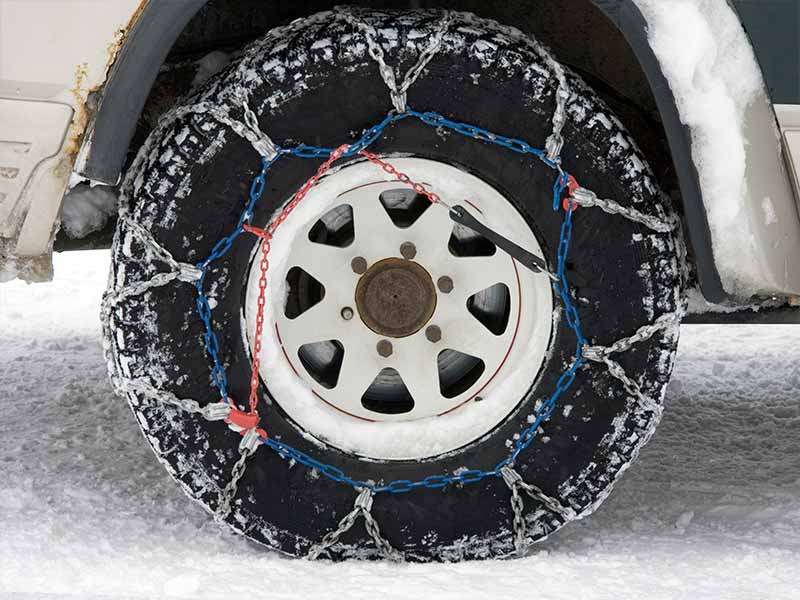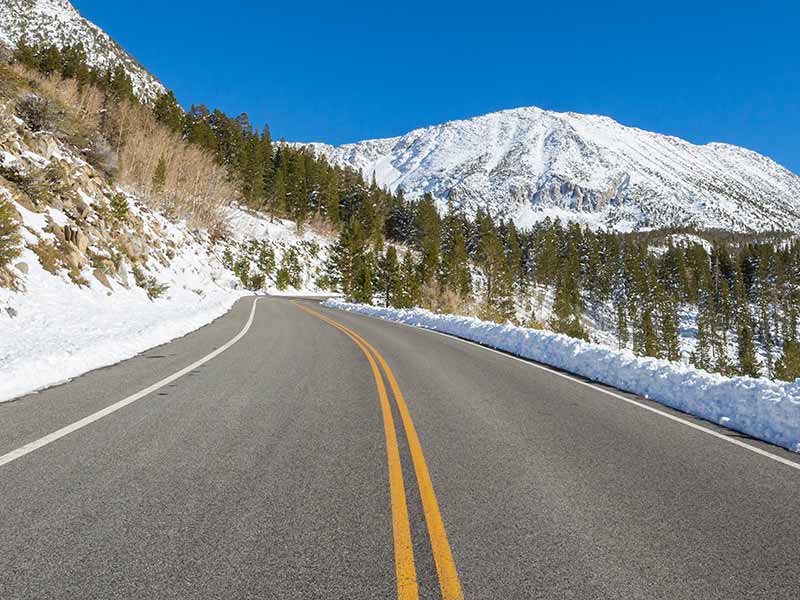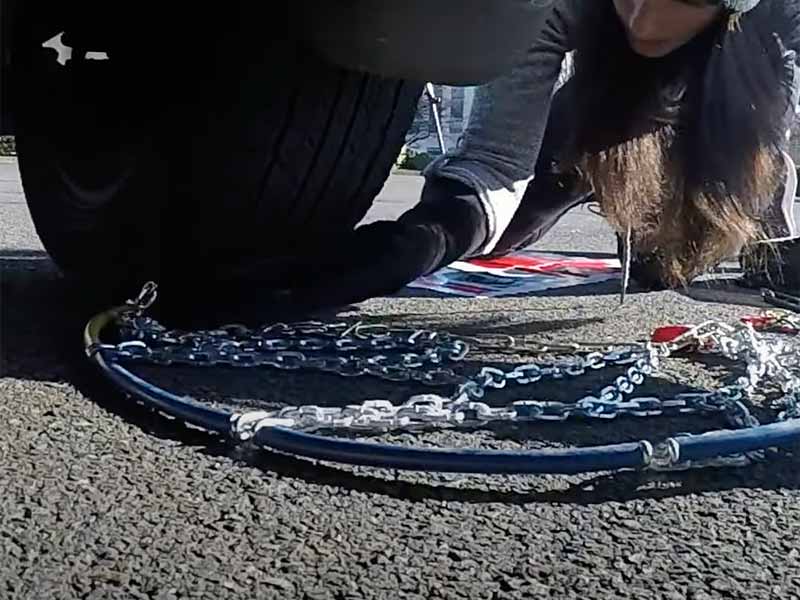Winter driving can be tricky, and knowing when to take off snow chains is crucial for your safety and your vehicle’s health. If you’ve ever wondered about the right time to remove those clunky, snow-biting chains from your tires, this article is your guide.
We’re diving into the world of tire chains, understanding not just their importance, but also the best practices for using them effectively.
When Should You Take Snow Chains Off?
You should remove snow chains from your vehicle when the roads are clear of snow and ice, and when you’re driving on dry pavement to prevent road and tire damage.
In this article, we delve into the practical aspects of using snow chains for safe winter driving. We cover when to put them on, the importance of observing local laws and restrictions, and crucially, how to recognize the right time to remove them.

Knowing When to Use Tire Chains
Using snow chains at the right time can make a big difference in how safely you can drive in winter weather.
The Right Conditions for Snow Chains
- Heavy Snow: When there’s a lot of snow on the road, tire chains can help your vehicle move through it without getting stuck.
- Icy Roads: Ice can make roads very slippery. Snow chains bite into the ice, giving your vehicle a better grip.
- Mountain Roads: In hilly or mountainous areas, snow and ice can be more dangerous. Chains are often needed here.
- Cold, Snowy Regions: If you live in a place where it’s cold and snowy a lot, you might need to use chains often in winter.
When Not to Use Tire Chains
It’s also important to know when not to use snow chains:
- Clear Roads: If the roads are clear and there’s no snow or ice, you don’t need chains. They can damage the road and your tires.
- Just a Little Snow: For light snow that doesn’t cover the road completely, you might not need chains.
- Dry Pavement: Driving on dry roads with chains can be bad for both the road surface and your chains.
Checking Local Laws
Different places have different rules about tire chains. It’s a good idea to:
- Look Up Laws: Before you travel, check the laws about snow chains in the area you’re going to.
- Watch for Signs: Sometimes there are signs on the road that tell you if you need to use chains.
Safety First
Always think about safety. If you’re not sure whether to use snow chains, it’s usually safer to put them on. And remember, even with chains, you should drive slower and more carefully in snowy or icy conditions.
For a deeper understanding of the laws around snow chains and when to use them, check out tire chain laws and restrictions. This will help you stay within legal limits and ensure safe driving during winter.

Legal Requirements and Restrictions
Different states have different rules, and it’s essential to know these to avoid problems and fines.
Understanding Tire Chain Laws
- Varies by Location: Laws about snow chains can be different depending on where you are. Some places require them under certain conditions, while others may not.
- Check Before You Travel: If you’re going to a new area in winter, it’s smart to look up their snow chain laws. This helps you be prepared.
- Signs on the Road: Sometimes, there are signs on the roads that tell you if you need to use snow chains. It’s important to follow these signs.
| State | Tire Chains Allowed? | Restrictions (if any) |
|---|---|---|
| Alabama | Yes | No specific restrictions* |
| Arizona | Yes | No specific restrictions* |
| California | Yes | Signs posted when required |
| Colorado | Yes | Commercial vehicles carry chains from Sept 1 – May 31 |
| Connecticut | Yes (Studded tires & non-skid devices from Nov 15 – April 30) | Specific dates for studded tires & non-skid devices |
| Delaware | Yes | No specific restrictions* |
| Florida | Yes | No specific laws |
| Georgia | Yes | No specific restrictions* |
| Hawaii | Yes | No specific laws |
| Idaho | Yes | No specific restrictions advised unless necessary |
| Illinois | Yes | No specific restrictions* |
| Indiana | Yes | No specific restrictions* |
| Iowa | Yes | No specific restrictions* |
| Kansas | Yes | No specific restrictions* |
| Kentucky | Yes (Ice-covered roads or vehicles with ice shoes 6 in wide) | Restrictions on diameter & spacing |
| Louisiana | Yes | No specific restrictions* |
| Maine | Yes | No specific restrictions* |
| Maryland | Yes (Required when a snow emergency has been declared) | Not allowed on vehicles weighing more than 10,000 lbs |
| Massachusetts | Yes | Permitted from Nov 1-May 1 |
| Michigan | Yes | No specific restrictions* |
| Minnesota | Yes (Permitted when road conditions call for it) | Studded pneumatic tires not allowed on state-registered vehicles |
| Mississippi | Yes | No specific restrictions* |
| Missouri | Yes | No specific laws |
| Montana | Yes (Permitted Oct 1-May 1) | Not mandatory unless notices are posted. Specific regulations for studded tires. |
| Nebraska | Yes (Metal studs only permitted Nov 1-April 1) | School buses, mail carrier vehicles, and emergency vehicles permitted year-round |
| Nevada | Yes (Required on all vehicles over 10,000 lbs when requirements in effect) | Studded tires permitted between Oct 1-April 30 |
| New Hampshire | Yes | No specific laws |
| New Jersey | Yes | No specific restrictions* |
| New York | Yes | Required when a snow emergency has been declared |
| New Mexico | Yes | No specific restrictions* |
| North Carolina | Yes | No specific restrictions* |
| North Dakota | Yes | No specific restrictions* |
| Ohio | Yes (Only permitted between Nov 1-April 1, except for public safety or school bus) | |
| Oklahoma | Yes | No specific restrictions* |
| Oregon | Yes (Required on vehicles over 10,000 lbs when SNOW ZONE signs are posted) | |
| Pennsylvania | Yes (Permitted between Nov 1-April 15) | Restrictions on the size of tires or studs |
| Rhode Island | Yes | No specific restrictions* |
| South Carolina | Yes | No specific restrictions* |
| South Dakota | Yes | No specific restrictions* |
| Tennessee | Yes (Permitted Oct 1-April 1) | Specific regulations on a percentage of wire or other material that comes in contact with the road |
| Texas | Yes | No specific restrictions* |
| Utah | Yes (Between Nov 1-March 31, if signs are posted, vehicles must have chains or snow tires) | |
| Vermont | Yes | No specific laws |
| Washington | Yes (Signs marked “chains required” will be posted) | On certain routes, chains must be carried from Nov 1-Mar 31 |
| Washington, D.C. | Yes | No specific laws |
| West Virginia | Yes | No specific restrictions* |
| Wisconsin | Yes | No specific restrictions* |
| Wyoming | Yes (Signs will be posted indicating when chain laws are in effect) | Must use adequate snow tires or chains |
*Some states have date restrictions, size restrictions, or specific vehicle type restrictions. Check with the state’s transportation department for specifics.
Restrictions and Considerations
There are also some restrictions and things to consider about using snow chains:
- Type of Chains: Some areas specify what type of chains you can use, like metal chains or cable chains.
- Speed Limits: When you have chains on, you usually have to drive slower. There’s often a maximum speed you can go with chains on.
- Road Damage Concerns: Using chains on dry roads can damage the road and your chains. This is why some places only allow chains in certain conditions.
Fines and Penalties
Not following the rules about snow chains can lead to fines:
- Check Fines: The fines for not using chains when required can be high. It’s better to be safe and follow the rules.
- Vehicle Damage: If you don’t use chains when you should, you might damage your vehicle, which can be costly.
Staying Informed
To make sure you’re following the rules and driving safely, it’s a good idea to stay informed about the local laws on snow chains. You can often find this information online or ask local authorities if you’re unsure.
For those interested in the specific rules and the types of snow chains allowed, exploring tire chain laws can provide more detailed insights. This knowledge will not only keep you legal but also ensure your safety on snowy and icy roads.

How to Determine If Snow Chains Should Be Removed
I understand how important it is to know not just when to put on snow chains, but also when to take them off. Removing snow chains at the right time is crucial for both your safety and the longevity of your chains.
Signs It’s Time to Remove Snow Chains
- Clear Roads: If the snow and ice have melted and the roads are clear, it’s time to take off the chains. Driving with chains on clear roads can damage both the road and your chains.
- Reduced Snow Coverage: When you see that the road is more clear than covered with snow, that’s a signal to remove the chains.
- Warmer Temperatures: As temperatures rise and the snow starts to melt, this is usually a sign that you no longer need the extra traction from chains.
Checking Your Vehicle and Chains
Before removing your chains, it’s good to:
- Inspect Your Chains: Check for any damage or wear. This helps you know if they’re still good or if you need new ones for the next use.
- Check Your Tires: Make sure your tires are in good condition after using chains. Look for any signs of wear or damage.
Safety Considerations
Always prioritize safety:
- Find a Safe Place to Remove Chains: Don’t just stop in the middle of the road. Find a safe spot, like a parking lot or a designated chain removal area.
- Be Mindful of Changing Conditions: Sometimes, the weather can change quickly. If you’re not sure about the road conditions ahead, it might be safer to keep the chains on a bit longer.
Remember
The key to using snow chains effectively is to balance the need for extra traction with the potential damage they can cause when used unnecessarily. Always be observant of the road conditions and weather forecasts.
For drivers who frequently face snowy conditions and are considering alternative options to tire chains, understanding the difference between snow tires and chains can be very helpful. This knowledge will assist in making informed decisions about the best way to maintain traction and safety in winter driving conditions.
Resources
Below are some links you may find helpful when learning about tires:
- How to drive on snow and ice – AAA
- Winter driving tips – National Highway Traffic Safety Administration
Final Thoughts
Snow chains provide essential traction in heavy snow and icy conditions, but they should be removed when you’re back on clear roads to avoid damage to the roads and your tires.
Always stay informed about local laws regarding snow chain usage, and ensure your chains are well-maintained and properly stored.
And don’t forget, alternatives like snow tires and studded tires can also be effective in winter conditions.
Good luck and happy motoring.





